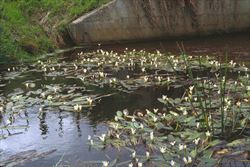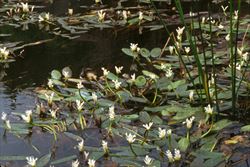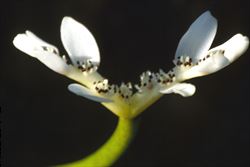Click on images to enlarge

infestation in a slow-moving waterway (Photo: Trevor James)

habit (Photo: Trevor James)

floating leaves (Photo: Rob and Fiona Richardson)

flower clusters (Photo: Rob and Fiona Richardson)

close-up of flowers (Photo: Rob and Fiona Richardson)

close-up of flowers from side-on (Photo: Trevor James)
Scientific Name
Aponogeton distachyos L. f.
Synonyms
Aponogeton distachyon L. f., orth. var.
Family
Aponogetonaceae
Common Names
Cape hawthorn, Cape pond lily, Cape pond weed, Cape pond-lily, Cape pondlily, Cape pondweed, Cape water hawthorn, Cape water-hawthorn, Cape-pondweed, dog with two tails, water hawthorn
Origin
Native to southern Africa (i.e. Cape Province in South Africa).
Naturalised Distribution
Naturalised in some parts of south-eastern Australia (i.e. in central and southern New South Wales, southern Victoria, Tasmania and south-eastern South Australia).
Also naturalised overseas in Europe (i.e. France and the UK), New Zealand, Argentina and south-western USA (i.e. California).
Notes
Cape pond lily (Aponogeton distachyos) is regarded as an environmental weed in Victoria and as a minor environmental weed or potential environmental weed in other parts of south-eastern Australia. This species is grown as an ornamental in outdoor aquaria and water features, and is popular because it grows and flowers during the winter months. It has escaped cultivation and invaded slow-moving freshwater creeks, rivers, lakes, dams and other water bodies.
Dense Cape pond lily (Aponogeton distachyos) infestations can alter aquatic ecosystems and shade out the native submerged flora. They also have the ability to change the physical and chemical characteristics of invaded lakes and waterways. This plant spreads by seeds and tubers and tends to invade sites in cooler temperate regions.
It is currently mainly a problem in Victoria, where it has become naturalised in several locations. For example, there is an outbreak of Cape pond lily (Aponogeton distachyos) located at Jackson's Creek in Osborne near Melbourne. It is regarded as a high threat weed species in aquatic herbland vegetation in the Warrnambool Plain bioregion and in aquatic grassy wetlands in the East Gippsland Lowlands bioregion. It is also listed as a common invasive garden escape in the Gannawarra and Loddon Shires.
Cape pond lily (Aponogeton distachyos) is also a minor weed of small water bodies in New South Wales and has been recorded in some conservation areas in south-eastern South Australia (i.e. Scott Creek Conservation Park and Cleland Conservation Park).

